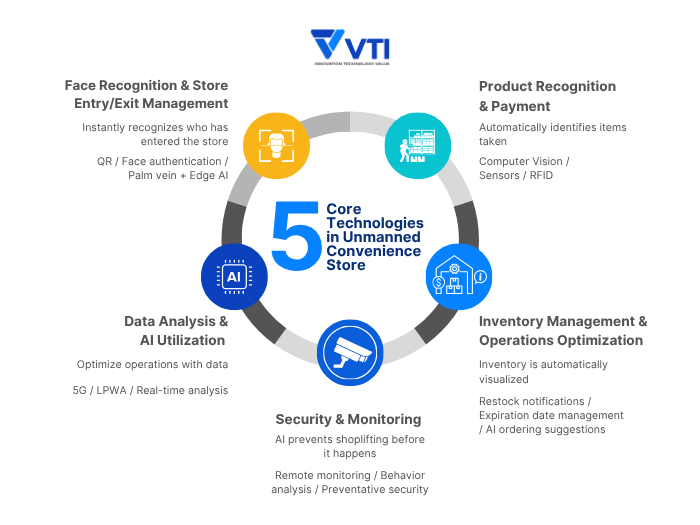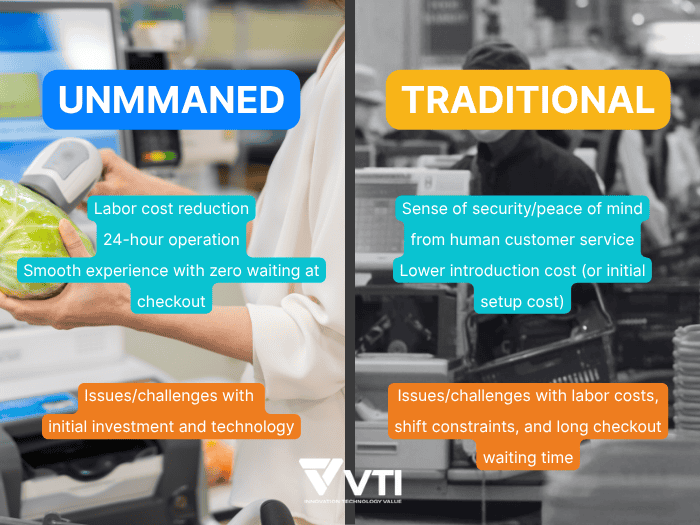Do you know that major chains like FamilyMart have announced strategies for the new era, planning to expand unmanned convenience stores to 1,000 locations. CP All operates approximately 12,000 locations, including 7-11 franchises, in Thailand and Southeast Asia. The global scale of convenience stores from these major players alone reaches well over 100,000 locations with many more smaller chains worldwide, indicating a very large global footprint. Of course, such massive expansion is never possible if they maintain the traditional model of in-store operation. The secret lies behind their application of AI and IoT in unmanned convenience store, which have completely different innovative mechanisms from traditional stores.
SO, what is an unmanned convenience store? What technology is being used to build a fully automated convenience store? This article will explain the specific applications of cutting-edge technologies in those automated stores so that you can apply them to your business.
What are Unmanned Convenience Stores?
Unmanned convenience stores are retail brick-and-mortar outlets that utilize cutting-edge technologies such as AI cameras, sensors, and IC tags (electronic tags attached to products) to automate in-store operations from cashier to customer service.
Shoppers can simply select products and walk out, with payment automatically completed. This significantly reduces their shopping time.
Since few or even no employees are required, labor cost reduction and 24-hour operation become possible with these fully automated convenience stores.
Globally, major retailers like Amazon and Walmart are leading the way in unmanned store technology. In Japan, major convenience store chains, including Seven-Eleven, Lawson, and FamilyMart, are advancing demonstration experiments utilizing unmanned store AI technology. For example, FamilyMart expanded “Fami Kiosk” (their unmanned payment system) to 1,000 locations nationwide by the end of fiscal year 2024.
Types of Unmanned Convenience Stores
Generally, there are 4 main types of unmanned convenience stores.
Vending Machine Type
Despite not being a brick-and-mortar store, this can still be regarded as the first type of automated convenience store. They feature small installation footprints and high convenience for placement anywhere. These are small automated machines installed in office buildings or factories, providing food, beverages, and daily necessities. They’re especially popular with office workers who cannot visit stores during crowded lunch hours.
“What The Cup” is a popular vending machine in Singapore offering more than 300 customizable drinks, including coffee, tea, protein shakes, and smoothies. It operates 24/7 at various locations such as Singapore Management University and Thomson Plaza, providing a wide selection for busy office workers and students within arm’s reach. Or in Thailand, “TAO BIN” smart beverage vending machines are well known for delivering fresh coffee and other beverages using robotic automation, installed in busy urban areas to serve the needs of customers seeking quality drinks without the wai
Self-Checkout Type
This is another type that requires no staff stationed, with users completing payment themselves using self-checkout registers. Customers scan product barcodes themselves and complete payment through cashless methods. For example, “NewDays”, a popular convenience store brand in Japan, operates unmanned stores with cashless-only self-checkout registers, where staff handle restocking and cleaning but are not permanently stationed.
Walk-Through Type
This type has no cash registers and processes payments through a dedicated app. First-time users are amazed, saying, “Just taking items and walking out feels like magic!” AI cameras and sensors automatically recognize when products are picked up, and payment is completed instantly through the app.
VTI’s “Scan & Go” stands out as a representative walk-through solution for unmanned stores. This system uses computer vision cameras, sensors, and deep learning technologies to track customer behavior in-store and items picked up in a virtual cart. This provides a true “just walk out” experience with no need to wait in line, reducing shopping time.
>>> Read more: 200+ Unmanned Stores Were Opened With The Help Of VTI
Hybrid Type
As the latest trend, operational formats combining fully automated convenience store systems with staffed services are gaining attention. Utilizing remote monitoring systems, flexible responses are possible, such as unmanned operation during daytime and remote staff monitoring at night. This new operational format is expected to balance cost efficiency with security and customer service quality.
Seven-Eleven’s demonstration experiment stores are testing operations combining 24-hour AI camera monitoring with staff dispatch when necessary. This is expected as a new unmanned convenience store operational format that balances cost reduction with security and customer service quality.
Advanced Technologies in Unmanned Convenience Stores

Customer Recognition and Entry/Exit Management Technology
The first technology needed in unmanned convenience stores is accurately identifying “who entered the store.”
Multiple authentication methods are currently used. The most common is QR code authentication, where codes displayed on dedicated apps are scanned at entrances.
More advanced stores have introduced facial recognition cameras and palm vein authentication, eliminating the need to even take out apps. Edge AI technology enables instant in-store processing, completing authentication in seconds.
Product Recognition and Payment Technology
This is the core unmanned store technology for identifying “what was taken” in unmanned convenience stores. Computer vision cameras installed on ceilings and product shelves instantly recognize products through AI algorithms. Weight sensors, depth sensors, and thermal sensors work together with advanced image recognition to identify products in real-time, making barcode scanning unnecessary.
Like Lawson’s “Robo-Regi,” bulk reading systems utilizing RFID tags (electronic tags) are also becoming widespread. This innovative system instantly recognizes all product information simply by placing items in a dedicated basket, completing automatic payment.
Inventory Management and Operations Optimization Technology
These technologies automate product replenishment timing and best-seller analysis. Shelf monitoring cameras constantly check product inventory levels, sending real-time notifications to staff wearable devices when replenishment is needed. Systems that make it “easy to see at a glance which products are low” also exist, with LED lights on electronic paper price tags illuminating to alert staff.
RFID tags also automate expiration date management, with products nearing expiration automatically displayed at reduced prices. AI management systems analyze past sales data and provide functions suggesting optimal product placement and ordering quantities.
Security and Monitoring Technology
Theft prevention is a critical challenge for unmanned convenience stores. Multiple cameras are positioned to eliminate blind spots, monitoring customer movements 360 degrees. When detecting suspicious behavior, the system will issue alerts, and the remote monitoring center staff to respond immediately.
The latest stores have introduced preventive systems where AI learns “normal shopping behavior” versus “abnormal behavior,” detecting potential shoplifting in advance. This enables safe operations even in urban areas where unmanned convenience stores are becoming widespread.
Data Analysis and AI Utilization Technology
These technologies convert collected data into valuable information. By analyzing customer purchasing patterns, product sales performance, and peak hours, they provide concrete improvement suggestions leading to increased sales. LPWA (Low Power Wide Area) technology enables efficient data collection from various sensors.
5G communication enables real-time data processing, with AI automatically generating specific operational instructions like “stock more coffee during this time period.” These technologies enable more efficient operations, surpassing traditional staffed stores.
Things to Consider Before Launching Your Unmanned Convenience Store

Major Advantages
Significant Labor Cost Reduction
Unmanned convenience stores automate cashier operations, eliminating the need for cashier staff. As one retail chain executive stated, “Even stores that had given up on nighttime operations due to labor shortages can now operate 24 hours.” Particularly in Tokyo, unmanned convenience stores can maintain profitability even in high-wage areas.
24-Hour Operation and Flexible Operating Systems
Freed from employee shift management, stable service provision is possible even late at night and early morning. Flexible operating hours can be set according to location, such as 7 AM in office districts and until 11 PM in residential areas.
Significant Customer Experience Improvement
Register waiting time becomes zero, providing an innovative shopping experience of “just taking products and walking.” Busy businesspeople highly value being able to “effectively use precious lunch break time.” A case report shopping time has been reduced to one-third through unmanned store technology.
Enhanced Safety Through Advanced Security
Computer vision cameras and various sensors can significantly reduce shoplifting and violent incidents. One survey reported that facial recognition cameras reduced violent incidents by over 90%. Safe store operations are realized through AI, instantly detecting abnormal behavior and notifying remote monitoring centers.
Things to Consider
High Initial Investment Costs
Excluding vending machine types, self-checkout and walk-through types require numerous advanced equipment installations. Some business operators voice concerns that “initial investment costs 3-5 times more than traditional stores,” creating a significant burden for small and medium enterprises. Equipment costs for AI cameras, various sensors, and communication devices, plus system development fees, tend to be expensive.
Limitations of Complete Automation
Human tasks remain necessary for product display, cleaning, and monitoring areas requiring age verification, like alcohol sales. The reality is “robot replacement is possible, but costs don’t justify it,” with partial staffing continuing even in many automated convenience store locations.
Technical Challenges and System Failures
Technical problems like product misrecognition, communication delays, and system failures can occur. Challenges exist, such as “camera accuracy dropping on rainy days” and “misrecognizing similar products,” with room for improvement in the completeness of unmanned convenience store mechanisms.
Customer Usage Resistance
There are accessibility issues for elderly people who prefer cash payment and users unfamiliar with smartphone app operations. Many voice concerns that “traditional stores feel more secure,” requiring time for acceptance across all customer segments.
Legal Regulations and Privacy Challenges
Legal guidelines regarding facial recognition technology and behavior monitoring remain undeveloped, with regulations varying by region. Some municipalities “postponed introduction from personal information protection perspectives,” making legal framework advancement essential for nationwide expansion.
Future Outlook and Trends
Dramatic AI Technology Advancement
Technologies supporting unmanned convenience stores are rapidly advancing. By 2025, autonomy and inter-system coordination capabilities are expected to improve, with advanced agent AI capable of parallel-processing multiple tasks becoming widespread. Product recognition errors are significantly decreasing through AI accuracy improvements, described as stores “almost seeming alive,” realizing more natural shopping experiences.
Edge AI technology proliferation enables in-store complete processing without cloud dependence. With zero communication delays, “real-time unmanned convenience stores” where payment completes the moment products are picked will become standard.
Integration with Robotics Technology
The global robotics market is predicted to reach $42.82 billion in 2024, with service robotics occupying a dominant $33.5 billion. In fully automated convenience stores, robot introduction for product display and cleaning is advancing in earnest.
A new business model called “RaaS (Robotics as a Service)” is spreading, with services enabling robot rental for monthly fees of several hundred thousand yen. This makes cutting-edge technology introduction easier, even for small and medium enterprises, moving one step closer to complete store automation.
Diversification of Operating Models
The shift from traditional “completely unmanned” to “hybrid type” is accelerating. Flexible operational formats are becoming mainstream, such as unmanned operation during daytime, remote monitoring at night, and staff dispatch only for emergencies. By providing “necessary support when needed,” we can balance both cost efficiency and customer satisfaction.
Particularly in urban areas like Tokyo, customized stores optimized for location characteristics are increasing, including office district-oriented, residential area-oriented, and station premise-oriented formats. “Adaptive stores” that automatically adjust optimal product placement by time period as AI learns user behavior patterns are also scheduled to appear.
Sustainability Considerations
Environmental considerations are becoming important elements in unmanned convenience store design. Lawson is advancing initiatives introducing solar power generation facilities for energy creation, reducing electricity usage by approximately 60% compared to standard stores.
Through automatic LED lighting dimming, AI-controlled air conditioning optimization, and active renewable energy utilization, “green unmanned convenience stores” that realize 30-50% energy savings compared to traditional stores are expected to become standard specifications. Movements introducing systems where AI predicts expiration dates for automatic price reductions and donation systems to nearby facilities are also emerging to reduce food waste.
Revolutionary Evolution of Customer Experience
Integration with smartphone apps will deepen further, with functions like “checking desired product inventory before entry,” “shortest route navigation,” and “product recommendations based on preferences” becoming standard. Supporting diverse payment methods, from QR codes, facial recognition, palm recognition, to voice payment, will become selectable according to user preferences.
Virtual staff voice guidance and AR technology-based product information displays are also planned for introduction to transform “shopping into an enjoyable experience.” Unmanned convenience stores are evolving from mere “efficient stores” to “places providing future shopping experiences.”
FAQ (Frequently Asked Questions)
What are the unmanned convenience store implementation costs?
Costs vary greatly depending on the introduced technology. For example, “Smalite” unmanned convenience stores can be implemented relatively low-cost, with initial costs from the 500,000 yen range and running costs from 8,000 yen monthly. However, full-scale systems often cost several million yen or more in initial expenses. Vending machine types can open stores from approximately 2 million yen with two vending machine installations.
When did convenience store automation begin?
Demonstration experiments began in earnest around 2018 in Japan. Currently, FamilyMart plans to deploy 1,000 unmanned payment stores, while Poplar operates 43 fully unmanned stores. However, most major chains remain at the labor-saving stage, with complete automation progressing gradually.
What is the shoplifting rate at unmanned convenience stores?
Specific statistics are not publicly released. Japan’s overall shoplifting damage exceeds 800 billion yen annually, with many shoplifting detection cases. However, unmanned stores reportedly have improved shoplifting detection rates compared to traditional stores through high-performance AI cameras and various sensors. Systems adopt structures making shoplifting impossible, with automatic payment completing simultaneously when doors open to take products and close.
Is security really adequate?
Multi-layered security measures ensure safety exceeding traditional stores. AI camera behavior analysis, real-time monitoring, and security gates are installed, with physical prevention measures like gates closing and preventing exit when attempting to take unpaid products. Emergency response systems by remote monitoring centers are also established.
Can elderly people and those unfamiliar with technology use them?
This currently remains a challenge. Many unmanned convenience stores assume smartphone apps and cashless payment, hindering elderly people and those unfamiliar with technology. However, efforts to improve accessibility are advancing, including voice guidance functions, enhanced operation support screens, and a combination with traditional cash payment.
Are there any legal issues?
Challenges exist from personal information protection perspectives regarding facial recognition technology and behavior monitoring. Currently, regulations vary by municipality, with unified national legal guidelines still under development. Therefore, establishing operational systems compliant with regional ordinances and personal information protection laws before introduction, and obtaining sufficient user explanation and consent, becomes important.
Conclusion
Unmanned convenience stores are gaining attention as innovative technology significantly transforming the retail industry’s future, beyond mere labor shortage countermeasures. The fusion of multiple cutting-edge technologies, including AI cameras, sensor technology, edge AI, and robotics, has made previously unimaginable shopping experiences of “just taking products and walking” possible.
Currently, diverse store formats from walk-through to hybrid types are being deployed in urban areas, starting with Tokyo, enabling customization according to each location and user needs. Shopping experiences described as “like a future world” receive high evaluations from busy businesspeople, with concrete results reporting shopping time reduced to one-third.
However, challenges remain requiring resolution, including high initial investment, technical challenges, and insufficient consideration for elderly people.
Toward 2030, unmanned store technology will evolve further, with sustainability considerations and AR technology-based customer experience improvements becoming standard. For the retail industry, this unmanned store technology is not optional, but an essential strategy for securing a competitive advantage.
For structural challenges facing the retail industry, including labor shortages and store saturation, unmanned convenience stores will increasingly play important roles as powerful solutions balancing efficiency and innovation.
About VTI
VTI provides one-stop software development solutions for digital transformation and business growth by utilizing cutting-edge technologies like AI and retail know-how. As an official Odoo partner, we provide Odoo services, including Odoo e-commerce systems. With abundant personnel experienced in e-commerce platforms like Magento and Odoo, we support building customized online shops for retail companies.
![[FREE EBOOK] Strategic Vietnam IT Outsourcing: Optimizing Cost and Workforce Efficiency](https://vti.com.vn/wp-content/uploads/2023/08/cover-mockup_ebook-it-outsourcing-20230331111004-ynxdn-1.png)




